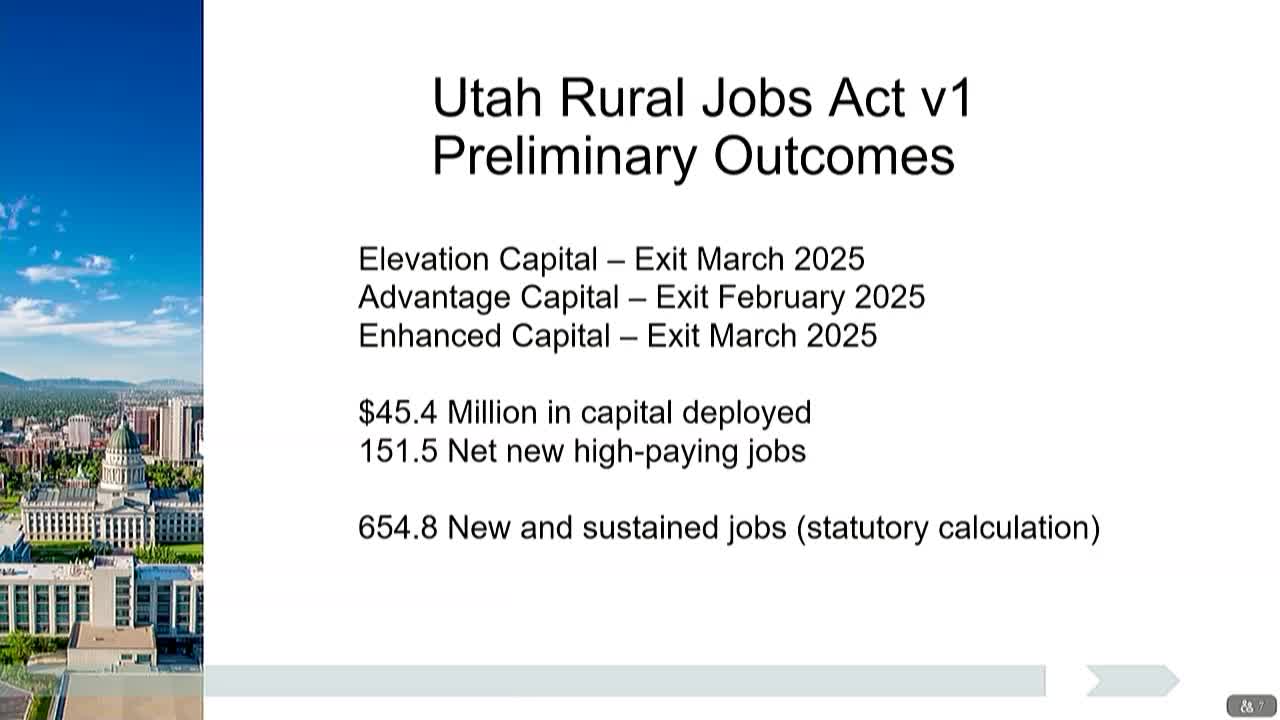Utah Legislature Evaluates Impact of Film Incentive Programs on Economic Development
August 20, 2025 | 2025 Utah Legislature, Utah Legislature, Utah Legislative Branch, Utah
This article was created by AI summarizing key points discussed. AI makes mistakes, so for full details and context, please refer to the video of the full meeting. Please report any errors so we can fix them. Report an error »

In a recent meeting of the Revenue and Taxation Interim Committee held on August 20, 2025, key discussions centered around the effectiveness and future of Utah's job creation and film incentive programs. The atmosphere was charged with anticipation as committee members reviewed the outcomes of various initiatives aimed at boosting employment and attracting film productions to the state.
The meeting began with a report on the nonrefundable rural job tax credit program, which has undergone significant changes since its inception. Following an audit that highlighted potential double counting in job creation metrics, the program was revamped in 2022. Currently, it has successfully facilitated the creation of 151 net new high-paying jobs across five rural companies, with plans for further expansion in the coming years. The committee is optimistic about achieving 100% deployment of funds by 2025, which would enable the issuance of approximately $6 million in tax credits annually for the next four years.
Transitioning to the film industry, economist Jared Gibbs presented a comprehensive overview of the refundable motion picture tax credit. He traced the evolution of the program from its establishment in 2005, highlighting various legislative changes that have shaped its current structure. The program now consists of three funding streams, including a cash rebate and two refundable tax credits aimed at incentivizing film production, particularly in rural areas. Gibbs emphasized the importance of measuring the program's effectiveness through the concept of "additionality," which assesses the actual economic impact of the incentives provided.
The data presented revealed that for every dollar invested in the film incentive program, the state sees a return of approximately $4 to $6 in economic activity, although tax revenue returns are significantly lower, estimated at 15 to 30 cents per dollar. This disparity raises questions about the sustainability and effectiveness of the program, especially as the legislature prepares for budgetary decisions that could impact funding levels.
As the meeting concluded, committee members were left to ponder the future of these programs. With the rural job tax credit poised for expansion and the film incentive program facing potential cuts, the discussions highlighted a critical juncture for Utah's economic development strategies. The decisions made in the coming months will not only shape the landscape of job creation and film production in the state but also reflect broader priorities regarding economic growth, rural community support, and the cultural identity of Utah.
The meeting began with a report on the nonrefundable rural job tax credit program, which has undergone significant changes since its inception. Following an audit that highlighted potential double counting in job creation metrics, the program was revamped in 2022. Currently, it has successfully facilitated the creation of 151 net new high-paying jobs across five rural companies, with plans for further expansion in the coming years. The committee is optimistic about achieving 100% deployment of funds by 2025, which would enable the issuance of approximately $6 million in tax credits annually for the next four years.
Transitioning to the film industry, economist Jared Gibbs presented a comprehensive overview of the refundable motion picture tax credit. He traced the evolution of the program from its establishment in 2005, highlighting various legislative changes that have shaped its current structure. The program now consists of three funding streams, including a cash rebate and two refundable tax credits aimed at incentivizing film production, particularly in rural areas. Gibbs emphasized the importance of measuring the program's effectiveness through the concept of "additionality," which assesses the actual economic impact of the incentives provided.
The data presented revealed that for every dollar invested in the film incentive program, the state sees a return of approximately $4 to $6 in economic activity, although tax revenue returns are significantly lower, estimated at 15 to 30 cents per dollar. This disparity raises questions about the sustainability and effectiveness of the program, especially as the legislature prepares for budgetary decisions that could impact funding levels.
As the meeting concluded, committee members were left to ponder the future of these programs. With the rural job tax credit poised for expansion and the film incentive program facing potential cuts, the discussions highlighted a critical juncture for Utah's economic development strategies. The decisions made in the coming months will not only shape the landscape of job creation and film production in the state but also reflect broader priorities regarding economic growth, rural community support, and the cultural identity of Utah.
View full meeting
This article is based on a recent meeting—watch the full video and explore the complete transcript for deeper insights into the discussion.
View full meeting

